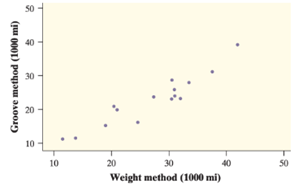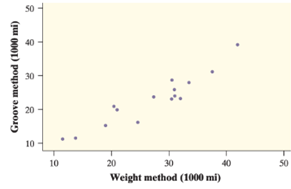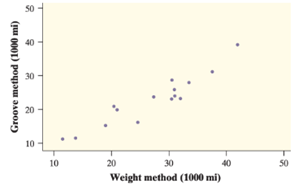
Concept explainers
(a)
To Explain: the 99% confidence interval for the slope of the population regression line is (0.5787, 1.0017).
(a)
Answer to Problem 22E
(0.5787, 1.0017)
Explanation of Solution
Given:


Formula used:
The boundaries of the confidence interval
Calculation:
The degrees of freedom is
The critical value can be found in table B in the mention row of
The boundaries of the confidence intervals are
The slight deviation is there due to rounding errors.
(b)
To find: that is there any difference in the two methods of the calculating the tire wears.
(b)
Answer to Problem 22E
Explanation of Solution
Given:


The two variables both calculate the tire wear in the same measurement units. If there is require to know if there is a difference, assume that there is no difference and there both require increasing by the same amounts, resulting in the null hypothesis
The alternative hypothesis statement is the opposite of the null hypothesis:
(c)
To find: the standardized test statistic and P-value on the basis of part (b) and conclusion at the
(c)
Answer to Problem 22E
Explanation of Solution
Given:


Formula used:
Calculation:
Finding the test statistic
Find
Find tail probability P
Looking at Table B in the row for 14 degrees of freedom and find that
Using the tail probability to find the P-value
The reason is that this is a two-tailed test (i.e. because this is a test for
The reason is that the p-value greater than our significance level of
(d)
To find: that the conclusion of part (a) and part (c) is same or not.
(d)
Answer to Problem 22E
There is no enough evidence to help the claim of a difference.
Explanation of Solution
Given:


Confidence interval mention in part (a)
(0.5785, 1.001)
The confidence interval 1 and therefore it is likely to get
Chapter 12 Solutions
PRACTICE OF STATISTICS F/AP EXAM
Additional Math Textbook Solutions
Statistics for Business and Economics (13th Edition)
Elementary Statistics: Picturing the World (7th Edition)
Intro Stats, Books a la Carte Edition (5th Edition)
Fundamentals of Statistics (5th Edition)
 MATLAB: An Introduction with ApplicationsStatisticsISBN:9781119256830Author:Amos GilatPublisher:John Wiley & Sons Inc
MATLAB: An Introduction with ApplicationsStatisticsISBN:9781119256830Author:Amos GilatPublisher:John Wiley & Sons Inc Probability and Statistics for Engineering and th...StatisticsISBN:9781305251809Author:Jay L. DevorePublisher:Cengage Learning
Probability and Statistics for Engineering and th...StatisticsISBN:9781305251809Author:Jay L. DevorePublisher:Cengage Learning Statistics for The Behavioral Sciences (MindTap C...StatisticsISBN:9781305504912Author:Frederick J Gravetter, Larry B. WallnauPublisher:Cengage Learning
Statistics for The Behavioral Sciences (MindTap C...StatisticsISBN:9781305504912Author:Frederick J Gravetter, Larry B. WallnauPublisher:Cengage Learning Elementary Statistics: Picturing the World (7th E...StatisticsISBN:9780134683416Author:Ron Larson, Betsy FarberPublisher:PEARSON
Elementary Statistics: Picturing the World (7th E...StatisticsISBN:9780134683416Author:Ron Larson, Betsy FarberPublisher:PEARSON The Basic Practice of StatisticsStatisticsISBN:9781319042578Author:David S. Moore, William I. Notz, Michael A. FlignerPublisher:W. H. Freeman
The Basic Practice of StatisticsStatisticsISBN:9781319042578Author:David S. Moore, William I. Notz, Michael A. FlignerPublisher:W. H. Freeman Introduction to the Practice of StatisticsStatisticsISBN:9781319013387Author:David S. Moore, George P. McCabe, Bruce A. CraigPublisher:W. H. Freeman
Introduction to the Practice of StatisticsStatisticsISBN:9781319013387Author:David S. Moore, George P. McCabe, Bruce A. CraigPublisher:W. H. Freeman





